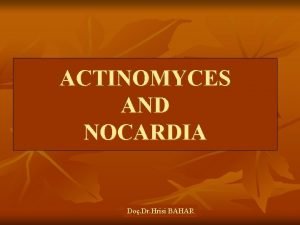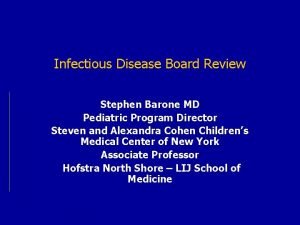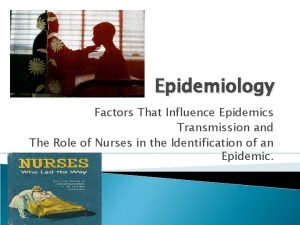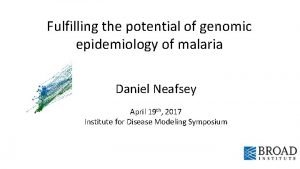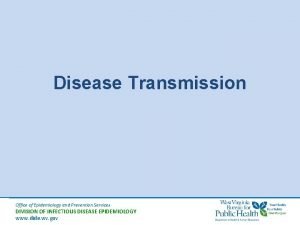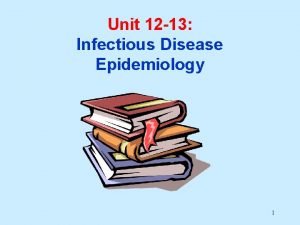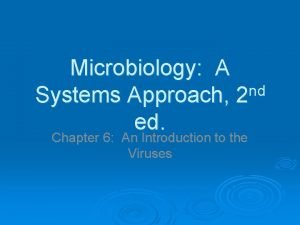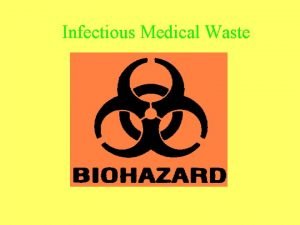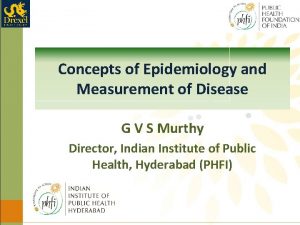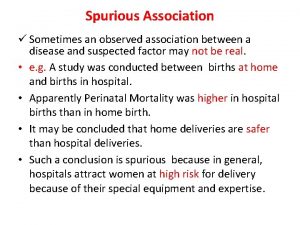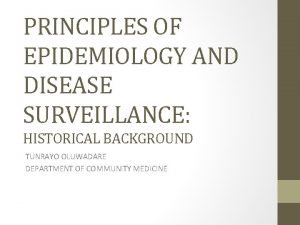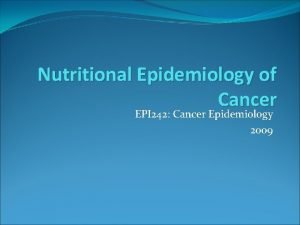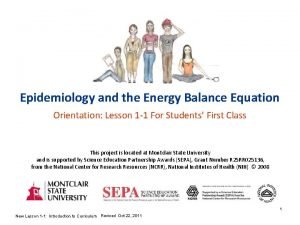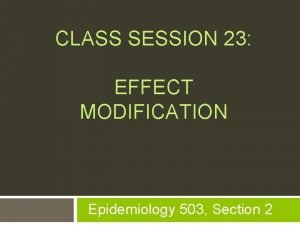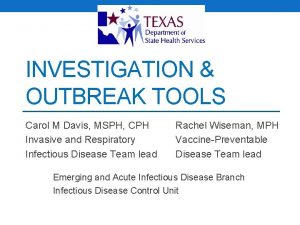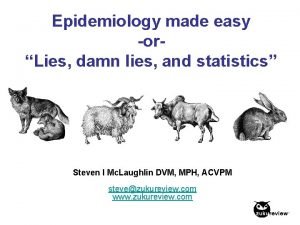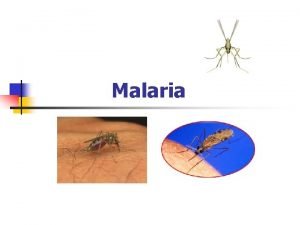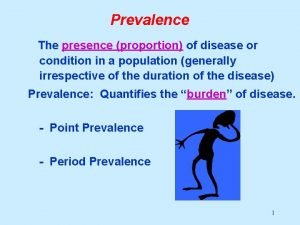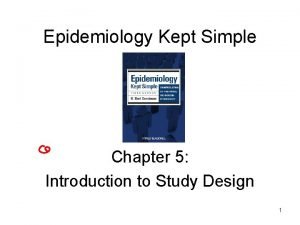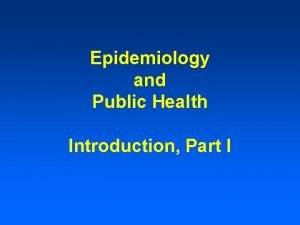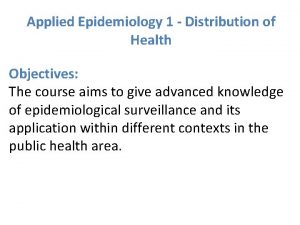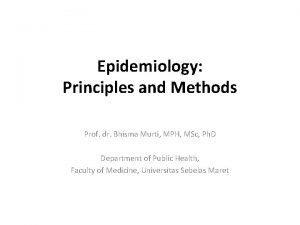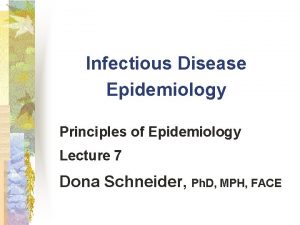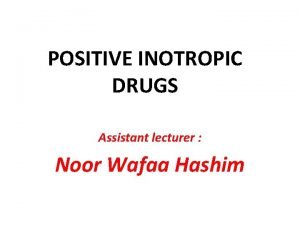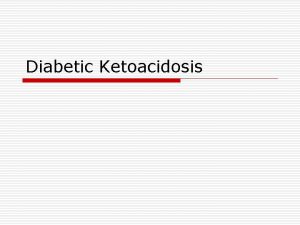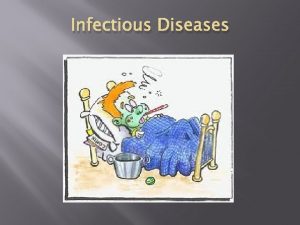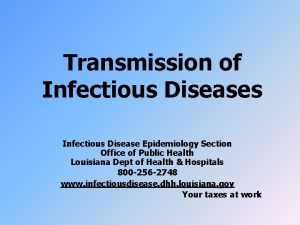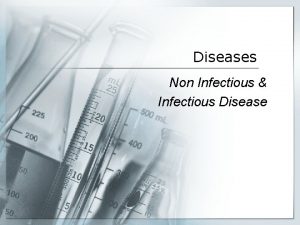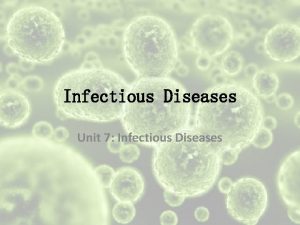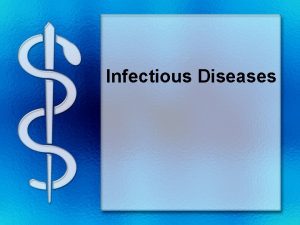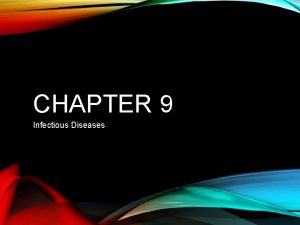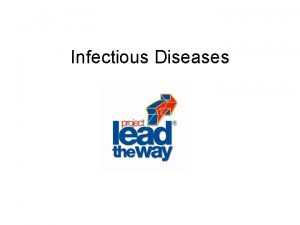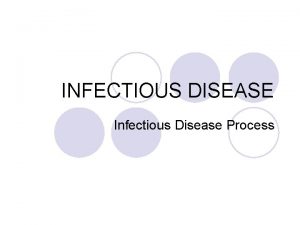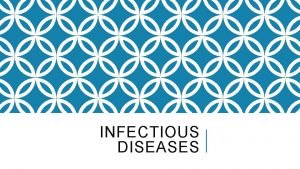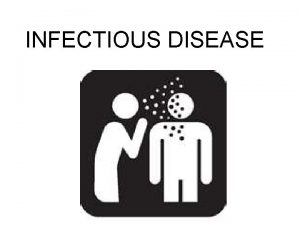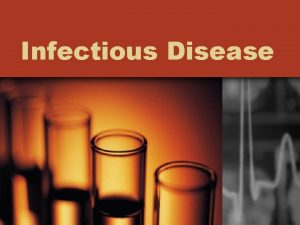INFECTIOUS DISEASES EPIDEMIOLOGY DYNAMICS OF DISEASE TRANSMISSION Dr



























































- Slides: 59

INFECTIOUS DISEASES EPIDEMIOLOGY: DYNAMICS OF DISEASE TRANSMISSION Dr. Urfi

DYNAMICS OF DISEASE TRANSMISSION (CHAIN OF INFECTION) Communicable diseases are transmitted from the reservoir/ source of infection to susceptible host 2

SOURCES AND RESERVOIR § Source of infection : The person, animal, object or substance from which an infectious agent passes or is disseminated to the host. § Reservoir : Any person, animal, arthropod, plant, soil, or substance, or a combination of these, in which an infectious agent normally lives and multiplies, on which it depends primarily for survival, and where it reproduces itself in such a manner that it can be transmitted to a susceptible host. ” 3

RESERVOIR AND SOURCES ARE NOT ALWAYS SAME Disease Source Reservoir Hookworm Tetanus Typhoid Soil Faeces/ Urine/ Food/ Water Man Soil Case/ Carrier Source refers to immediate source of infection and may or may not be a part of reservoir 4

TYPES OF RESERVOIRS Can be Homologous or Heterologous Reservoir Human Reservoir Animal Reservoir Non-living Reservoir 5

Human Reservoir Cases Carriers 6

CASES A case is defined as “a person in the population or study group identified as having the particular disease, health disorder, or condition under investigation” 7

Human Reservoir Cases Type: • Primary case • Index case • Secondary cases According to spectrum of disease: • Clinical cases (mild/severe-typical/atypical) • Sub-clinical cases • Latent infection Type: • Incubatory • Convalescent • Healthy Duration: • Temporary • Chronic Carriers Portal of exit: • Urinary • Intestinal • Respiratory • Others 8

According To Spectrum Of Disease: I. Clinical Cases: Ømay be mild or moderate, typical or atypical, severe or fatal depending upon the gradient of involvement Ømild cases may be more important sources of infection than severe cases because they are ambulant and spread the infection wherever they go, whereas severe cases are usually confined to bed 9

II. Subclinical Cases: Ø Referred as inapparent, covert, missed or abortive cases Ø The disease agent may multiply in the host but does not manifest itself by signs and symptoms ØThe disease agent is eliminated and it contaminates the environment in the same way as clinical cases ØPlay a dominant role in maintaining the chain of infection (endemicity) in the community ØCan be detected only by laboratory tests ØE. g. Polio, Influenza, Hepatitis A and B 10

III. Latent Cases: ØIn latent infection, the host does not shed the infectious agent which lies dormant within the host without symptoms ØOften without demonstrable presence in blood, tissues or bodily secretions of the host ØE. g. Herpes simplex 11

ØPrimary Case: Refers to the first case of a communicable disease introduced into the population unit being studied ØIndex Case Refers to the first case to come to the attention of the investigator; it is not always the primary case ØSecondary Case Secondary cases are those developing from contact with primary case 12

CARRIERS ØA carrier is an individual who harbors the organism but is not infected as measured by serologic studies (no evidence of an antibody response) or by evidence of clinical illness ØElements in a carrier state: state Ø Presence of disease agent Ø Absence of signs and symptoms Ø Shedding of disease agent in discharges or excretions 13

ØAs a rule, carriers are less infectious than cases ØEpidemiologically, they are more dangerous than cases because they escape recognition, and continuing as they do to live a normal life among the population or community ØThey readily infect the susceptible individuals over a wider area and longer period of time, under favorable conditions 14

Human Reservoir Cases Type: • Primary case • Index case • Secondary cases According to spectrum of disease: • Clinical cases (mild/severe-typical/atypical) • Sub-clinical cases • Latent infection Type: • Incubatory • Convalescent • Healthy Duration: • Temporary • Chronic Carriers Portal of exit: • Urinary • Intestinal • Respiratory • Others 15

TYPES OF CARRIERS Incubatory Convalescent Healthy • Infect others during incubation period • e. g. Measles, mumps, poliomyelitis, influenza, hepatitis B • Continue to shed disease agent during the period of convalescence • e. g. Typhoid fever, dysentery, cholera. • Subclinical infection progressing to carrier state without suffering from overt disease, • e. g. polio, cholera, meningococcal meningitis, salmonellosis Person with subclinical infection may or may not be a carrier 16

BASED ON DURATION Temporary Carriers Ø Shed the infectious agent for short periods of time ØIncubatory, convalescent and healthy carriers Chronic Carriers ØExcretes the infectious agent for indefinite periods Ø E. g. , typhoid fever, hepatitis B, dysentery, cerebra- spinal meningitis, malaria, gonorrhoea, etc 17

CHRONIC CARRIERS ØThe longer the carrier state, the greater the risk to the community Ø The duration of the carrier state varies with the disease ØChronic carriers are known to reintroduce disease into areas which are otherwise free of infection (e. g. , malaria) Ø Early detection and treatment are essential to limit the spread of infection ØCarriers of avirulent organisms are called pseudocarriers; not important epidemiologically 18

ØMary Mallon (1869 – 1938), better known as Typhoid Mary, was the first person in the US identified as an asymptomatic carrier of the pathogen associated with typhoid fever ØShe was presumed to have infected some 50 people, three of whom died, over the course of her career as a cook ØShe was forcibly isolated twice by public health authorities and died after a total of nearly three decades in isolation 19

By Portal Of Exit Of Infectious Agent Route Disease Respiratory Influenza Fecal (intestinal) Typhoid, Cholera Blood HIV, Hepatitis B Urinary Typhoid Sexual Gonococcus, HIV The portal of exit and the occupational status of the carrier are important epidemiological considerations 20

ANIMAL RESERVOIRS ØZoonosis is an infection that is transmissible under natural conditions from vertebrate animals to man, e. g. rabies, plague, yellow fever, influenza, bovine tuberculosis ØThere are over a 100 zoonotic diseases that can be conveyed from animal to man ØThe role of pigs and ducks in the spread of epidemic and pandemic influenza both as reservoirs, carriers and "amplifying hosts” 21

ØOrnithosis and arboviruses can be transmitted to man from various birds ØWild birds are important hosts in the transmission cycles of most of the mosquito borne encephalitis ØBirds may carry ticks infected with viruses and rickettsiae that may cause disease in humans 22

RESERVOIR IN NON-LIVING THINGS ØSoil and inanimate matter can also act as reservoir of infection. ØFor example, soil may harbor agents that causes § tetanus, § anthrax and § Coccidiodomycosis ØWater contaminated by human or animal feces cause GI tract disease 23

MODES OF TRANSMISSION ØDepend upon the infectious agent, portal of entry and the local ecological conditions Ø As a rule, an infectious disease is transmitted by only one route Ø May also be transmitted by several routes e. g. , AIDS, salmonellosis, hepatitis B, brucellosis, Q fever, etc ØThe multiple transmission routes enhance the survival of the infectious agent 24

Mode of transmission Direct Transmission Indirect Transmission Direct contact Vehicle-borne Droplet infection Vector-borne: • Mechanical • Biological Contact with soil Inoculation into skin or mucosa Air-borne Trans-placental (vertical) Unclean hands and fingers Propagative Cyclo-propagative Cyclo-developmental Fomite-borne 25

DIRECT TRANSMISSION Direct contact • STI, HIV/AIDS, • Leprosy, skin and eye infections Droplet infection • TB, diptheria, common cold Contact with • Hookworm, tetanus, mycosis etc. soil Inoculation Transplacental • Rabies by dog bite, Hepatitis B through syringe • TORCH, AIDS, Hepatitis B, varicella 26

DIRECT CONTACT ØInfection may be transmitted by direct contact from skin to skin, mucosa to mucosa, or mucosa to skin of the same or another person ØThis implies direct and immediate transfer of infectious agents from the reservoir or source to a susceptible individual, without an intermediate agency Ø e. g. , skin-to-skin contact as by touching, kissing or sexual intercourse or continued close contact 27

DROPLET INFECTION ØDirect projection of a spray of droplets of saliva and naso- pharyngeal secretions during coughing, sneezing or speaking and spitting, talking in to the surrounding atmosphere ØThe droplet spread is usually limited to a distance of 30 -60 cm between source and host. ØParticles of (10) mm or greater in diameter are filtered off by nose; Those (5) mm or less can penetrate deeply and reach the alveoli 28

INDIRECT TRANSMISSION Through contaminated 5 F’s – § Food, § Fluid, § Fomite, § Flies, § Fingers. Factors: § Characteristics of agent § Environment- temperature, humidity § Drug resistance 29

Mode of transmission Direct Transmission Indirect Transmission Direct contact Vehicle-borne Droplet infection Vector-borne: • Mechanical • Biological Contact with soil Inoculation into skin or mucosa Air-borne Trans-placental (vertical) Unclean hands and fingers Propagative Cyclo-propagative Cyclo-developmental Fomite-borne 30

1. Vehicle-borne: Ø Through agency of water, food, ice, blood, serum, plasma or through biological products like tissues or organs Ø Water: Cholera, HAV, HEV, Typhoid etc. Ø Food: Staphylococci, Cl. Botulinum Ø Blood/serum: HIV, HBV, HCV, Malaria Ø Organ: CMV by kidney transplant 31

EPIDEMIOLOGICAL FEATURES OF VEHICLE TRANSMISSION Ø(a) If the dose of contamination is heavy, the outbreak may be explosive as in the case of cholera and hepatitis A epidemics Ø(b) Cases are initially confined to those who are exposed to the contaminated vehicle Ø(c) When secondary cases occur, the primary case may be obscured 32

Ø(d) The distance travelled by the infectious agent may be great, e. g. , outbreaks of food poisoning Ø(e) It is not always possible to isolate the infectious agent in the incriminated vehicle, e. g. , typhoid bacilli in contaminated water Ø(f) When the vehicle is controlled or withdrawn, the epidemic subsides, e. g. , epidemics of cholera Ø(g) The common source of infection is often traceable 33

2. Vector-borne: Vector is an arthropod or any living carrier that transports an infectious agent to susceptible host a. Mechanical: Ø by soiled feet or proboscis of arthropod as the arthropod crawls or fly Ø through excreta Ø There isn’t any development or multiplication of the infectious agent on or within the vector b. Biological: Ø Disease agent passes through a developmental cycle or replication cycle or both in the vector & requires an incubation period 34

TYPES OF BIOLOGICAL TRANSMISSION IN VECTORS PROPAGATIVE Multiplies but no change in form. E. g. plague bacilli in rat fleas CYCLOPROPAGATIVE Changes in form and number. E. g. malarial parasite in mosquito. CYCLODEVELOPMENTAL Only development no multiplication. E. g. microfilaria in mosquito. 35

Trans-ovarial Transmission & Trans-stadial Transmission ØWhen the infectious agent is transmitted vertically from the infected female to her progeny in the vector, it is known as trans-ovarial transmission Ø Transmission of the disease agent from one stage of the life cycle to another as nymph to adult is known as trans-stadial transmission 36

FACTORS INFLUENCING VECTOR BORNE TRANSMISSION ØHost feeding preference ØInfectivity-ability to transmit disease agent ØSusceptibility – ability to become infected ØSurvival rate of vectors in environment ØDomesticity ØSuitable environmental factors 37

3. Air Borne I. Droplet Nuclei ØThey are tiny particles (1 -10 microns range) that represent the dried residue of droplets ØThey may be formed by: i. evaporation of droplets coughed or sneezed into the air ii. generated purposefully by a variety of atomizing devices (aerosols) ØTuberculosis, influenza, Q fever and nosocomial infections 38

II. Dust ØSome of the larger droplets which are expelled during talking, coughing or sneezing, settle down by their sheer weight on the floor, carpets, furniture, clothes, bedding, linen and other objects in the immediate environment and become part of the dust ØA variety of infectious agents and skin squamae have been found in the dust of hospital wards and living rooms ØStaphylococcal infection, pneumonia, tuberculosis, Q fever and psittacosis 39

4. Fomite Borne ØInanimate objects other than food and water ØE. g. diptheria, typhoid fever, bacillary dysentery, eye and skin infections 40

5. Unclean Hands And Fingers ØHands are the most common medium by which pathogenic agents are transferred to food from the skin, nose, bowel as well as from other foods ØThe transmission takes place both directly (hand-to- mouth) and indirectly ØLack of personal hygiene coupled with poor sanitation favour person-to-person transmission of infection ØStaphylococcal and streptococcal infections, typhoid fever, dysentery, hepatitis A and intestinal parasites 41

SUSCEPTIBLE HOST § § An infectious agent seeks a susceptible host aiming “successful parasitism” Four stages are required for successful parasitism: 1. Portal of entry 2. Site of election inside the body 3. Portal of exit 4. Survival in external environment 42

43

SUCCESSFUL PARASITISM § Site of Election: After entering the host the organism reaches appropriate tissue where it may find optimum condition for its multiplication and survival § Portal Of Exit: The disease agent finds a way out of body so that it reaches a new host and propagate its species. If no portal of exit, infection becomes dead end E. g. rabies, bubonic plague, tetanus, trichinosis 45

§ Survival In Environment: After leaving the host the organism must survive in the external environment till new host is found § Successful disease agent should not cause the death of the host but only produce low grade immunity so that host is vulnerable again & again to the same infection 46

CHARACTERISTICS OF AGENT § Infectiousness: Relative ease with which the agent is transmitted to the host; more of function of environmental factors § Infectivity: The ability of the agent to cause infection, i. e. , to enter, survive, and multiply in the host § Useful epidemiological measure of infectivity is secondary attack rate (SAR) § Virulence: The ability of agent to produce severe disease § Pathogenicity: The ability of the agent to manifest disease out of those who have been infected 47

RISK FACTORS TO INFECTION 48

IMMUNITY & SUSCEPTIBILITY § The amount of disease in population depends upon a balance between number of people in that population who are susceptible, and therefore at the risk for the disease, and the number of people who are not susceptible, or immune, and therefore not at risk § Immunity: Prior disease or due to immunization § Entire population immunized: No epidemic § Usually a balance exists between immunity and susceptibilty 49

HERD IMMUNITY § The resistance of a group of people to an attack by a disease to which a large proportion of members of the group are immune § If a large percentage of population is immune, the entire population is likely to be protected, not just those who are immune § Why does herd immunity occurs? § Because the disease spreads from one person to another in any community § Likelihood is small that an infected person will encounter a susceptible person to whom he can transmit the infection; more of his encounters will be with people who are immune 50

FOR HERD IMMUNITY… § The disease must be restricted to single host species within which transmission occurs § Transmission must be relatively direct from one member of host species to another § Infections must induce solid immunity § What percentage of population must be immune for herd immunity to operate? § Herd immunity due to OPV: Contacts are immunized by the spread of virus from the vaccinated person 51

INCUBATION AND LATENT PERIODS Incubation period: § The time interval between invasion by an infectious agent and the appearance of the first sign or symptom of the disease in question § Reflects the time needed for the organism to replicate sufficiently § Incubation period varies for different infectious diseases and also from one person to other within same disease Median incubation period: § Time required for 50 percent of cases to occur following exposure 52

Factors determining incubation period: § Generation time of particular pathogen, infective dose, portal of entry & individual susceptibility Disease infectious during IP: § Measles, chicken pox, whooping cough, hepatitis A Latent period: § A term used for non-infectious diseases § Defined as the period between disease initiation to disease detection 53

EPIDEMIOLOGICAL IMPORTANCE OF INCUBATION PERIOD § Tracing the source of infection and contacts – e. g. in food poisoning § Period of surveillance or quarantine– equivalent to maximum incubation period of disease § Immunization- prophylactic use of human Ig and anti- sera § Identification of point source or propagated epidemic – in case of point source epidemic all cases occur within one incubation period of the disease § Prognosis: shorter I/P = worse prognosis e. g. tetanus, rabies 54

SERIAL INTERVAL AND GENERATION TIME Serial interval: § The gap in time between the onset of the primary and the secondary cases § Can be used to elicit information about incubation period Generation time: § The interval between receipt of infection and maximal infectivity of the host § Roughly equal to incubation period 57

§ Different from incubation period § Applicable in clinical & subclinical infection also while incubation period only among manifest diseases § With person to person transmission of infection, the interval between cases is determined by the generation time 58

COMMUNICABLE PERIOD ØTime during which an infectious agent may be transferred directly or indirectly from an infected person to another person, from an infected animal to man, or from an infected person to an animal, including arthropods ØCommunicability varies in different diseases ØCommunicability of some diseases can be reduced by early diagnosis and treatment 59

SECONDARY ATTACK RATE The number of exposed persons developing the disease within the range of the incubation period, following exposure to the primary case Number of exposed persons developing the disease within the range of the incubation period SAR = __________________ X 100 Total number of exposed / susceptible contacts 60

§ The denominator consists of all persons exposed to the case § More specifically denominator may be restricted only to susceptible contacts, if means are available to distinguish the susceptible persons from the immune § Restricted to infectious diseases in which primary case is infective for only a short period of time 61

Secondary attack rate § 90% in chickenpox § 90% in whooping cough § 86% in mumps § 80% in measles disease § These are highly communicable diseases 62
 Icd 10 morbus hansen
Icd 10 morbus hansen Epidemiological triad of malaria
Epidemiological triad of malaria Infectious disease
Infectious disease Chapter 26 infectious disease prevention and control
Chapter 26 infectious disease prevention and control Hennepin county infectious disease manual
Hennepin county infectious disease manual Stages of infectious disease
Stages of infectious disease Smallest infectious agents
Smallest infectious agents Infectious disease quality controls
Infectious disease quality controls Stridor
Stridor Periods of infectious disease
Periods of infectious disease Factors that influence disease transmission
Factors that influence disease transmission Disease transmission
Disease transmission Chapter 19 disease transmission and infection prevention
Chapter 19 disease transmission and infection prevention Disease transmission
Disease transmission Chapter 19 disease transmission and infection prevention
Chapter 19 disease transmission and infection prevention Chapter 19 disease transmission and infection prevention
Chapter 19 disease transmission and infection prevention Infectivity definition
Infectivity definition Communicable disease and non communicable disease
Communicable disease and non communicable disease Infectious stunting syndrome
Infectious stunting syndrome Infectious canine hepatitis in dogs
Infectious canine hepatitis in dogs Infectious mononucleosis
Infectious mononucleosis Infectious canine hepatitis in dogs
Infectious canine hepatitis in dogs Hhps octagon meaning
Hhps octagon meaning Infectious nucleic acid
Infectious nucleic acid Quizlet
Quizlet Waste management definition
Waste management definition Infectious mononucleosis
Infectious mononucleosis Distribution in epidemiology
Distribution in epidemiology Spurious association in epidemiology
Spurious association in epidemiology Defination of epidemiology
Defination of epidemiology Descriptive vs analytical epidemiology
Descriptive vs analytical epidemiology John snow epidemiology
John snow epidemiology Nutritional epidemiology
Nutritional epidemiology Epidemiology definition
Epidemiology definition Gordon nichols
Gordon nichols Rambo critical appraisal tool
Rambo critical appraisal tool Thesourceagents
Thesourceagents Epidemiology definition
Epidemiology definition Effect modification epidemiology
Effect modification epidemiology Field epidemiology ppt
Field epidemiology ppt Endemic definition in community health nursing
Endemic definition in community health nursing Bibliography of epidemiology
Bibliography of epidemiology Epidemiology made easy
Epidemiology made easy Perbedaan relative risk dan odds ratio
Perbedaan relative risk dan odds ratio Prevalence calculation formula
Prevalence calculation formula Mp test for malaria
Mp test for malaria Prevalensi adalah
Prevalensi adalah Epidemiology kept simple
Epidemiology kept simple What is the wheel model of causation
What is the wheel model of causation Person place and time model in epidemiology
Person place and time model in epidemiology Define epidemiology
Define epidemiology Distribution in epidemiology
Distribution in epidemiology Bhisma murti
Bhisma murti Association and causation
Association and causation Define nutritional epidemiology
Define nutritional epidemiology Cross sectional study advantages and disadvantages
Cross sectional study advantages and disadvantages Formula for attack rate
Formula for attack rate How dr. wafaa elsadr epidemiology professor
How dr. wafaa elsadr epidemiology professor Diabetic ketoacidosis epidemiology
Diabetic ketoacidosis epidemiology Period prevalence vs point prevalence
Period prevalence vs point prevalence


